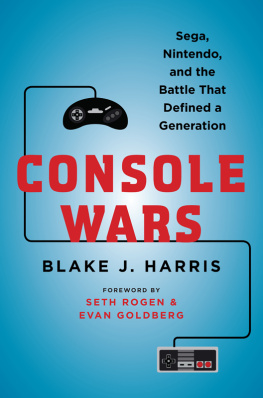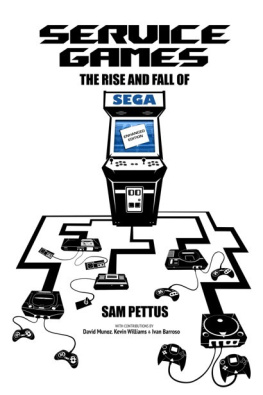
Also by KEN HOROWITZ
Playing at the Next Level: A History of American Sega Games (McFarland, 2016)
The Sega Arcade Revolution
A History in 62 Games
Ken Horowitz

McFarland & Company, Inc., Publishers
Jefferson, North Carolina
LIBRARY OF CONGRESS CATALOGUING DATA ARE AVAILABLE
BRITISH LIBRARY CATALOGUING DATA ARE AVAILABLE
e-ISBN: 978-1-4766-3196-7
2018 Kenneth S. Horowitz. All rights reserved
No part of this book may be reproduced or transmitted in any form or by any means, electronic or mechanical, including photocopying or recording, or by any information storage and retrieval system, without permission in writing from the publisher.
Front cover image 2018 iStock
McFarland & Company, Inc., Publishers
Box 611, Jefferson, North Carolina 28640
www.mcfarlandpub.com
To all the people who made Sega the arcade powerhouse that it was for decades. Their continued dedication to creativity, innovation, and quality made my childhood that much better. The men and women of Segas arcade divisions who produced so many hit games over the years were a constant presence for me. In every mall, every supermarket, and each convenience store and laundromat, they were there.
To my wife and children, who I know have refrained from rolling their eyes at the mention of anything Sega purely out of their love for me. They support these projects, and they do so because they see how much they interest me. My love for everything Sega is well-known in my house, and through it all, my family has never wavered.
To Irving Bromberg, Martin Bromley, James Humpert, Richard Stewart, and Raymond LeMairethe men who laid the foundation for what became Sega. Additionally, it is dedicated to David Rosen, who forged the path that made Sega into a video game legend. I especially dedicate this book to all those at Sega Enterprises USA who built the company up during the 80s and all throughout the 90s. They fueled the childhoods of so many young video gamers and gave us classic title after classic title. Lastly, I dedicate this work to two giants that the video game industry lost in 2017: Former Sega Amusements President Alan Stone, who passed in February and former Sega Enterprises USA President Tom Petit, who died in November. Stone co-founded Nintendo of America and was President and COO of Segas North American arcade business from 1994 to 2004, and Petit co-founded and was President of Segas U.S. arcade division from 1987 to 1994. They will be missed.
Acknowledgments
I am indebted to many people for their contributions to this work, but there are some former Sega alumni that made this project something personal. They made sure that I got my facts straight and that I spoke to the right people. Steve Hanawa, Tom Petit, Elizabeth Falconer, and Ramiro (Medo) Morenothank you all for all your help. Thank you for letting me tell your Sega stories.
I must also acknowledge the Herculean efforts of this projects translator, Andrej Preradovic of Translation++ (http://www.translationplusplus.com/). He spent countless hours combing through Japanese interviews and articles, and his insight into Japanese culture provided invaluable context to many of the situations and discussions that fueled the chapters of this book. His enthusiasm and professionalism were contagious, and I could not have written this book without him.
On that same note, I must thank Alex Highsmith of Shmuplations.com, who provided many of the Japanese interviews for this project. His cooperation and friendliness are much appreciated, and it was a true pleasure working with him. He runs an incredible website resource that video game fans everywhere should permanently bookmark.
My thanks must also be extended to RePlay, Play Meter, and Cash Box magazines, Hasan Ali Almaci, Lauran Bromley, George McAuliffe, Tom Petit, and Kevin Keinert for providing images for this work; as well as to Ethan Johnson and Alex Smith for their extensive collaboration and feedback.
Preface
Unlike most video game companies that were founded and continued under a single name until purchased or closed, Segas origins are considerably more complex. The entity that we know today as Sega is the culmination of several mergers and buyouts, and identifying the tangled history of this beloved publisher can be something of a strain, particularly regarding its earliest years. Its corporate timeline has so many twists and turns that not even its official company website includes them all.
For this reason, a detailed chronicle of Segas origins will not be attempted here. It is indeed important to know how Sega began, and every effort is made to tell that story as completely as is relevant to the subject matter of this book. Those thirsting for a deeper examination of Segas start should consult Keith Smiths excellent Golden Age Arcade Historian blog, which specializes in exhaustive research into the origins of many arcade companies and games. The site served as a starting point for several portions of this book, and Smiths detailing of the history of Sega is quite comprehensive.
Instead, this book servesjust as the title saysas a celebration of one of the arcade industrys most prolific and innovative companies. Though many of the titles included were historic milestones, the only real criteria for their inclusion were that they have an interesting story that might not be common knowledge and that they were significant in Segas history. To have the histories of these games in a single tome is hopefully something that Sega and arcade fans will find interesting and useful.
Games are discussed, within each chapter, in roughly chronological order. The original Japanese or simultaneous worldwide release dates are used when available.
The Arcade Origins of Sega
Segas arcade history is a fascinating tale of a company that spanned many countries on three different continents, as well as several changes in ownership. What never wavered over all this time and during all these transitions was Segas continuous ability to innovate. Long before the rise of its fabled Amusement Machine (AM) division, there were people in the United States, the United Kingdom, and Japan who displayed an unceasing dedication to pushing the envelope. On most occasions, it seemed like the rest of the industry followed in their creative wake.
To understand how this innovative culture developed, one must delve deep into Segas corporate past. Video arcade games didnt become a notable industry until the 1970s, and by then Sega had already established itself as one of the premier makers of coin-operated amusement machines in the world. To get a better picture of how Sega achieved that status, we should begin this tale with an examination of the companys founding and development.
The Early Years (19451965)
As many are aware, Segas origins are decidedly American. The company we know today may have been based in Japan for the last few decades, but it had its start with some business-minded U.S. military men serving in a tropical paradise. Amusement game distributor Irving Bromberg, his son Martin (who would later change his name to Bromley), and James Humpert began their long journey toward the company that would one day be known as Sega by selling slot machines and coin-operated devices on American military bases in Hawaii. Bromberg, the son of Ukrainian Jewish immigrants, had run a car company and operated his own coin-op amusement machine business, the Irving Bromberg Company, out of Brooklyn, Boston, and Washington, D.C. He began distributing coin-ops, including the historically important
Next page










